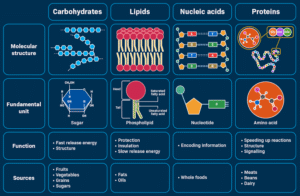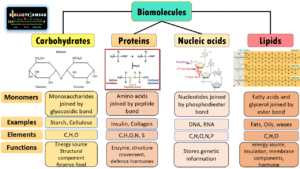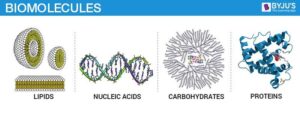Back to: Organic Chemistry 300 Level
Welcome to class!
Hello, brilliant learner! Today, we will explore two very important groups of biomolecules — lipids and amino acids. Lipids give us the rich taste of palm oil and the energy of groundnut paste, while amino acids are the building blocks that form the proteins in our bodies, from muscles to enzymes. By the end of this lesson, you will see how these molecules connect what we eat to how our bodies function.
Biomolecules II – Lipids & Amino Acids
Meaning and Importance of Lipids

Lipids are a diverse group of hydrophobic or amphipathic molecules made mostly of carbon and hydrogen, with a small amount of oxygen. They are not polymers like carbohydrates or proteins but play essential roles in energy storage, cell structure, and signalling.
Classification of Lipids
Simple lipids: Fats and oils (esters of fatty acids and glycerol).
Complex lipids: Phospholipids, glycolipids, lipoproteins.
Derived lipids: Steroids, fat-soluble vitamins (A, D, E, K).
Functions of Lipids
Energy storage (more than twice the energy per gram compared to carbohydrates).
Structural components of membranes (phospholipids, cholesterol).
Insulation and protection.

Hormone precursors (e.g., steroid hormones).
Fatty Acids
Saturated fatty acids: No double bonds; e.g., palmitic acid (found in palm oil).
Unsaturated fatty acids: One or more double bonds; e.g., oleic acid (in olive oil), linoleic acid (essential fatty acid).
Essential Fatty Acids
These cannot be synthesised by the body and must be obtained from the diet — such as omega-3 and omega-6 fatty acids, found in fish and some plant oils.
Meaning and Importance of Amino Acids
Amino acids are organic molecules containing an amino group (-NH₂), a carboxyl group (-COOH), a hydrogen atom, and a distinctive side chain (R group) attached to a central carbon. They are the monomers that form proteins.
Classification of Amino Acids
Based on polarity: Non-polar (glycine, alanine), polar uncharged (serine, threonine), polar charged (lysine, glutamate).
Based on nutritional requirement: Essential (must be obtained from diet, e.g., leucine, valine) and non-essential (can be synthesised by the body, e.g., alanine, aspartic acid).
Functions of Amino Acids
Building proteins for structure (muscles, skin) and function (enzymes, hormones).
Precursors for neurotransmitters (e.g., tryptophan → serotonin).
Energy source during prolonged fasting.
Peptide Bond Formation
Amino acids link together by a condensation reaction between the amino group of one amino acid and the carboxyl group of another, releasing water and forming a peptide bond.
Nigerian Context
Lipids: Palm oil, groundnut oil, coconut oil, and suya fat are rich sources of lipids.
Amino acids: Beans, eggs, fish, and meat supply essential amino acids. Understanding these biomolecules is important in tackling malnutrition and developing fortified foods in Nigeria.

When glycerol combines with three fatty acid molecules, it forms a triglyceride (fat or oil). Similarly, when two amino acids like glycine and alanine combine, they form a dipeptide through a peptide bond, releasing a water molecule.
Summary
- Lipids are hydrophobic molecules used for energy storage, membrane structure, and signalling.
- They are classified into simple, complex, and derived lipids.
- Fatty acids can be saturated or unsaturated; essential fatty acids must come from diet.
- Amino acids are protein monomers, classified by polarity and nutritional requirement.
- Peptide bonds link amino acids to form proteins, which are vital for structure and function.
Evaluation
- Define lipids and state two functions.
- Mention three classes of lipids with one example each.
- Distinguish between saturated and unsaturated fatty acids.
- Define amino acids and state their main function.
- Explain how a peptide bond is formed.
You now understand two of life’s most important molecular groups — the energy-rich lipids and the versatile amino acids. With Afrilearn, every lesson brings you closer to mastering the chemistry that powers living systems.
